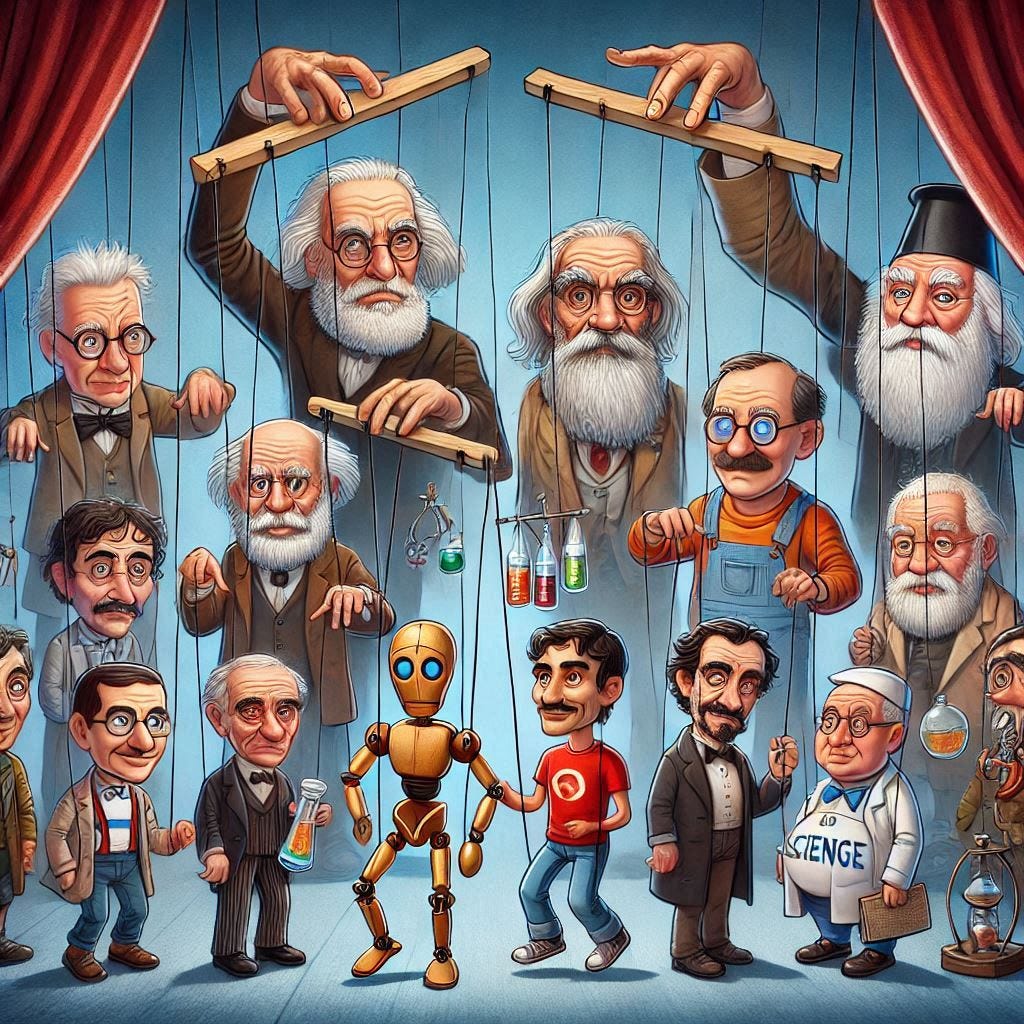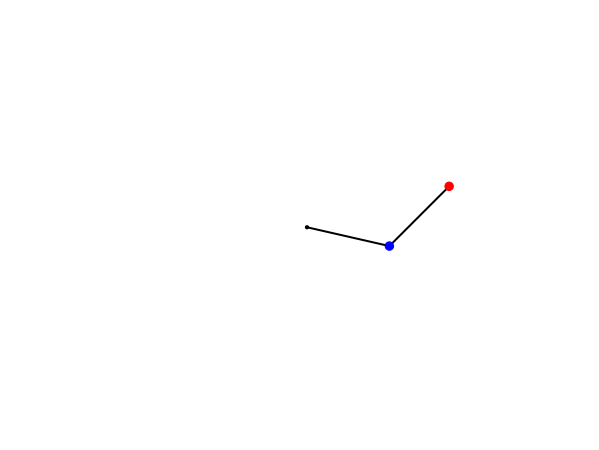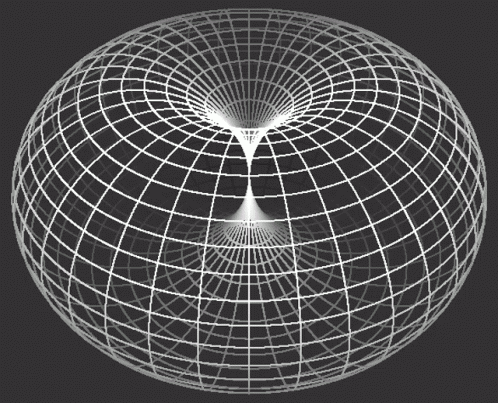On Attaining Spiritual Sight (Part I)
"Consider the What, but consider the How still more." - Goethe
The ‘Formal’ Context of Seeing
When we perceive the meaning of our perceptual flow - our sensations, thoughts, feelings, and desires - it is always through a certain ‘formal’ structure; a nested context of factors through which the meaning shines forth and makes itself known. This context influences in what manner we direct our attention, to what we direct our attention, and how we perceive and understand what our attention is directed to. It includes, most proximately, factors such as our opinions, beliefs, preferences, worldviews, temperament, native language, the ‘spirit’ of our cultural age, and so on, asymptotically approaching our intuition for the total potential of what existence could be. How we perceive, think, feel, and act (collectively, “spiritual activity”) is modulated by these factors, which function as constraints on our spiritual activity and its degrees of freedom to transform its present state into new mental, emotional, and sensory states. Although we can speak of these factors as being nested like a word is nested in a sentence, a sentence in a paragraph, etc., each factor also overlaps with all others in complex ways and the whole constellation of factors modulates the constraints and possibilities of our spiritual activity at any given state.
For example, we can imagine we are in a philosophical conversation with a friend about the ‘nature of reality’. Further imagine that we have formed a rigid belief that feelings and thoughts are mere ‘epiphenomena’ emerging from mindless and mechanistic neurochemistry (a belief that most of us pass through in modern times). This belief will act as a constraint that steers our spiritual activity away from ideal states imbued with the meaning of supersensible realities, i.e. ideas associated with experiences independent of the bodily-sensory support. When our friend begins discussing such states that he has experienced or has heard reported from other spiritual sources, the constraining belief will numb our sensitivity to the meaningful import of our friend’s concepts. No matter how harmoniously that meaning resonates with other facts of our living experience and our accumulated knowledge, we will find rationalizations to explain it away. At the time, however, we will probably convince ourselves that we are rationally evaluating the meaning and reaching the only possible logical conclusion.
Such constraints are not limited to reductive materialists, of course. We could also imagine a discussion with our religious friend who believes the Creator is separate from his creation, and therefore His creatures cannot become as creatively responsible for that creation as He is. This belief will steer our friend’s activity away from mental states that imply humanity can develop forms of spiritual activity that are not merely abstract reflections on experience or the rearrangement of dead mineral elements, but which work creatively into the psycho-physical structure of existence. If we begin discussing these higher forms of spiritual activity, our friend will find ways to ignore or rationalize them away. We could survey many more modern beliefs which constrain spiritual activity in similar ways. An especially problematic constraint is the belief that these constraining factors apply to everyone else’s spiritual activity, but not to our own. This particular constraint, synonymous with pride, keeps itself in the shadows and makes it impossible for our spiritual activity to illuminate the factors constraining it.1
Naturally, then, our spiritual activity can only explore more expansive spheres of meaning when it becomes conscious of and then loosens these constraints. We can analogize the latter to a diving suit that is fitted over our spiritual activity. Through the conditioning of natural development and modern cultural experience, i.e. the ‘dive’ into selfish tendencies, rigid physical-sensory experience, and associated philosophical-religious-scientific ideas about the nature of existence, our activity is constrained tightly by its suit. Our bodily will and emotional life are clearly the most tightly constrained, for example we can’t rotate our head 180 degrees or easily switch from a state of melancholy to a state of joy. Our thinking, on the other hand, wiggles some of itself free of the suit’s mask and generates imaginative replicas of bodily experience in the head space. These replicas can be more easily transformed and rearranged in the most varied ways. For example, our inner thinking voice is a replica of the bodily experience of speaking through the vocal tract and hearing sounds through the ears, yet through it we can begin exploring the meaning of states well beyond our personal bodily life, like those related to global economics, politics, religious ideas, etc. (generally what other souls may be experiencing).
Nevertheless, the meaning that can be explored through our imaginative life is still highly constrained by various factors, such as the beliefs we mentioned above, but also our sympathies and antipathies, our language, our temperament, and so on. We can surely imagine our head spinning 180 degrees, but why did we choose to spin it clockwise or counterclockwise? That remains a mysterious imaginative constraint. We also can’t imagine new types of experience that we never went through in our bodily life, for example new colors and tones. In that sense, the imaginative life is still constrained by the bodily context just like our head and limbs, except the former can access a greater spectrum of content at any given time and rearrange it in varied ways, like we have become skilled contortionists. We can press our physical hands together and feel the resistance, and then we can imaginatively simulate the same experience and allow the ghostly imaginary hands to pass right through one another. Practically all modern thinking about the ‘nature of existence’ are comprised of contorted arrangements of mental pictures that are ghostly replicas of bodily experiences (most often visual, but also audial, tactile, etc.).
So our ordinary imaginative degrees of freedom (including intellectual thinking) are much more constrained than we prefer to imagine. We express our intellectual convictions about politics, religion, the environment, and so on, yet we are hardly aware from what bodily experiences throughout life we are drawing upon to shape them. This mysterious quality of the constraints on our imaginative life was intuited by certain modern philosophers (e.g. Kant), as discussed more extensively in this essay, who then concluded that we can never directly know these constraints. We can only know our already constrained mental pictures (constrained by ‘a priori categories’ of knowing). Such philosophers failed to notice that there is an overlap between our constrained mental pictures and the ‘constraints themselves’, and that overlap manifests precisely in the imaginative life that has slightly wiggled out from the rigid (and even more mysterious) physical-sensory constraints. What follows should be understood as not only a philosophical description of that overlap, but as a means of experiencing that overlap and heightening our sensitivity to it through metaphors, illustrations, examples, and associated lines of reasoning.
How our Thoughts Participate in the Constraints that Shape Them
When we discuss the nature of the inner constraints with concepts, as we are doing now, it is as if we are dimly swimming through mental pictures of their felt meaning as they impress their constraining ‘forces’ into our imaginative organization and shape those pictures. Then we extract more limited packets of meaning from that pictorial flow and ‘encode’ them as the audial forms of our inner voice, which we can manipulate in various ways and possibly objectify on the screen. Keep in mind we are using these familiar spatial images as symbolic descriptions of entirely first-person inner experience (of which spatial experience is only a subset). We are not speaking of any exotic dimensions in which these ‘encodings’ exist, but only using the imagery as an artistic symbol for completely verifiable aspects of our immanent experiential flow. Thus, we can only properly orient to these symbolic concepts, such as “encoding”, if we remain active in our imaginative life and try to experience how the intuitive meaning we are instinctively steering through is continually focused into the mental pictures and verbal forms we use to anchor that meaning (like the words of this essay). It is expected that this will be difficult at first, but just like learning any new skill, practice makes perfect.
Thus our imaginative organization acts as a prism through which the holistic yet blurry light of intuitive meaning is continually focused into more narrow yet sharply defined sequences of mental pictures and verbal thoughts that attempt to explicate the meaning. Imagine how the blurry color amalgamation perceived through a camera or binocular are more clearly focused when you adjust the lenses - we are continually doing something similar with our invisible imaginative gestures that bring forth mental pictures (thoughts). Our thoughts are then experienced coming into focus as highly 'sliced and diced' intuitive meaning. As another example, when we speak of the ‘neurosensory system’, we may not have any well-defined physiological understanding, but nevertheless we can try to experience the totality of our sensory inputs in any given state - colors, sounds, smells, tactile, etc. - as superimposed and interacting with our psychic and bodily organizations. We can then sense how we focus that dim intuitive experience into a tree-like branching mental picture (brain and nerves) and the corresponding verbal symbols through our imaginative gestures.
Another helpful example to consider is that of mathematical thinking, since the symbolic pictures are not directly drawn from sensory experience and therefore we more clearly sense that the intuitive meaning comes from the opposite direction of those pictures, so to speak. When we imagine two sides of a triangle before ‘incarnating’ the third side which must necessarily connect them, our spiritual activity first weaves in timeless ideal relations and focuses that intuitive meaning through the prism of certain mysterious imaginative constraints which are intuitively felt. It takes time to perform the geometric operation but we know the meaningful relations between the sides are always the same. Then we can later focus that felt intuition of the timeless constraints into the symbolic concepts of “mathematical laws”, “mathematical logic”, and so on. It is critical to get a good feel for how all such intellectual concepts and ‘laws’ were originally born from the felt intuitive meaning of our spiritual activity and its constraints, even when we consider more sense-based fields of inquiry like history, geography, physics, biology, etc. (although many of these are increasingly mathematized).
By actively and livingly exploring the constraints on our imaginative life in this way, we are also beginning to loosen the nuts and bolts on the mask of the rigid diving suit, or to use another metaphor, to put more slack in the customary strings that normally dangle our imaginative being and make it dance hither and thither like a marionette. The first step is always to become conscious of these strings because otherwise they remain in our blind spot and we imagine we are in full control of our inner movements, forming our philosophical, religious, and scientific thoughts as our own original and free expressions. We initially gain that consciousness by resisting certain default constraints through our active imaginative explorations. When we resist the constraints with our spiritual activity, it is as if the latter drags against the ordinary channels that continually try to format its expression. The resulting ‘friction’ provides the basis for our activity to gain inward (intuitive) sensitivity to the constraints, just as we become more acutely aware of a current in the ocean when we try swimming against it.
Loosening the Most Proximate Constraint on Imaginative Activity
We should notice how this is why thinking works, i.e. why thinking inquiries can lead to insights into the experiential flow. When the chemist decides to investigate the reaction of substances, for example, there are many other things he could allow his spiritual activity to flow along with, i.e. various sympathetic and convenient sensuous pleasures (like the animal does). Instead, he resists those preferred pleasures and directs his spiritual activity against the normal soul flow to devote time and effort towards setting up the experiment, perhaps motivated by the ideal of contributing new knowledge to society. In the process of conducting the experiment, his spiritual activity drags against the normal flow and certain meaningful intuition feeds back, like the meaning of sensory transformations indicating a new substance precipitating from the reaction. This meaningful feedback provides genuine insight into the contextual depth of existence, even if at a very fragmented scale. The common error that occurs here, however, is the chemist failing to understand the feedback is related to his own inner life - his own soul and spiritual structure - instead imagining the meaning points to some other reality ‘behind’ or ‘beyond’ the sensory appearances.
Surely the chemical reaction is not caused by the chemist’s personal imaginative activity, but its meaning can only shine forth through the contextual factors that structure this activity. This sort of ignorance can make our thinking efforts useful for myopic aims in the short-term, but it is untruthful and therefore unproductive for attaining spiritual sight within deeper scales of existence. When we remain ignorant of the truthful process, the meaningful feedback on our imaginative resistance does nothing to shift or heighten the underlying cognitive experience, since our attention is sucked entirely into its surface-level content. We should try to feel this very clearly. When philosopher A contorts imaginative replicas and concludes that “the Big Bang created the Universe”, and philosopher B does the same and concludes that “God created the Universe”, the cognitive experience of thinking these ‘opposite’ conclusion is practically equivalent. That would only change if one of the philosophers was struck by the insight that his conclusion also testifies to the hidden ideal lawfulness through which it was formed and in which he continuously participates.
Thus, the first constraint to resist and become more conscious of is the rigid modern habit of treating our concepts as definitions and models that are imagined to “explain” the “nature” of our inner constraints as if the latter are realities which are external to our spiritual activity. In that case, we feel that we can encompass the constraints in our ordinary mental perspective, measuring and analyzing them from a safe distance as we generally do with phenomenal processes in the kingdoms of Nature. What follows should be understood as a practice in exactly this resistance, so that the default cognitive strings slacken and we can more clearly sense how the meaningful feedback on our spiritual activity relates to our intuitive context. Then we can also start to distinguish between what we are freely contributing to our intuitive movements, on the one hand, and what movements are still being tugged by shadowy strings - impulses, feelings, and habits - on the other. We are then beginning to probe the ‘geometry’ of the inner constraints with our spiritual activity.
Consider how we wordlessly remember events in our lives when we were particularly active, like a sporting event we participated in, as if surfing through a panorama of memory images. This memory intuition of the event constrains the way we move our remembering activity - we aren’t interested in recalling any images, for example an image of what we had for breakfast yesterday, but only those which fit harmoniously within the ‘intuitive curvature’ of the sporting event. Any disharmonious images within our intuitive context are quickly filtered out, they ‘destructively interfere’ such that we never even become aware of them. Then, if we want to express constructively interfering images more precisely to ourselves or others, we focus them into symbolic forms that are constrained by the ‘prismatic lenses’ of our acquired languages, our speech skills, the particular organization of our throat and larynx, etc. Of the infinite possible ways of expressing meaning, only those words, expressions, intonations, articulations, etc. that are allowed by these various overlapping constraints will be manifested in our speech.
In that sense, our verbal concepts and mental pictures symbolizing the constraints (stimulated by the perceptions of this essay) are also genuine experiences of the constraints themselves, i.e. encodings of their felt intuitive meaning. The concepts we are now using to describe the constraints are themselves filtered through the constraints they are describing. Thus, our concepts have become recursive and point attention toward various aspects of the process through which they were birthed, sort of like they are blood spatter patterns which can testify to the way in which a crime was committed. Sometimes these patterns can even point to underlying motivations - was the crime committed in a momentary fit of rage or in a premeditated and methodical fashion? Again, with these metaphors we are simply elucidating the reasons why thinking works to provide potential insights in all cases, trying to become more explicitly aware of what otherwise remains unconscious and is taken for granted.
That is also the case even in our intellectual thinking where the relationship isn’t so explicit, as in the case of the chemist. Then, our concepts implicitly point back at the formal context through which they manifested, yet another level of indirection has been introduced. If we imagine our explicitly symbolic concepts about the contextual constraints (such as we are using here) as a one-arm pendulum, where the movements of the arm (concepts) closely mirror the meaningful intuitive ‘point’ around which it oscillates, our scientific thinking with implicitly symbolic concepts is like adding a second arm, where the movements become much more complicated reflections of that underlying intuitive meaning.
When we attend solely to the complex pendulum swings of our conceptual life, i.e. the content of our oscillating thoughts, which is by far the prevailing habit today, we invariably lose sight of their continuity with the intuitive points around which they revolve (yet the continuity still exists). To attain spiritual sight, we need to reorient attention toward the thinking process itself, which normally hides in the background. It doesn’t matter if we are thinking about whizzing electrons, multiplying cells, transformations of ‘libido’, hierarchies of spiritual beings, or the Final Judgment - we always gain more living and holistic insight into the experiential flow when we see the resulting thoughts as testimonies to the real-time thinking process. We learn to retrace through the complicated reflections of thoughts into the intuitive context that shapes their movements - first our beliefs, assumptions, preferences, motivations, etc. - and with expanding insight we can streamline our thoughts to exert less of a chaotic pull on our soul context. To attain a proper orientation to this retracing possibility, we need to understand that this entire intuitive context is always immanent in our present state of being.
Intuitive Meaning Always Lives in our Present State
In all cases, the meaningful experiences that form the basis of our conceptual encodings are still living in our present state. When surfing through memory pictures of the sporting event and verbalizing the words, “That was a great game but I could have played better”, we are experiencing the same meaning we experienced during the game, although there is the additional meaning of the states we have experienced since the game which provides a new perspective on the original meaning. A great deal of the game’s qualitative significance is lost in the translation, including the quality of temporal immediacy. Analogous to how a large computer image may lose a lot of its crisp resolution when it is compressed into a smaller format, the constraining memory intuition becomes something nebulous, insubstantial, and temporally distant when we focus attention solely on its symbolic encodings (whether verbal, pictorial, physical gestures, etc.). The meaning of what we were sensing, thinking, feeling, and doing during the sporting event, in all its rich and immanent qualities, will mostly be obscured or aliased by the encodings.
To heighten sensitivity to this principle, consider the example of biologists observing stages of human development and producing mental images imbued with the meaning of how rhythmic life processes lawfully constrain these developmental stages of the human organism as it grows from embryo to mature adult. The thoughts about these living constraints are clearly also constrained by those same developmental stages. The biologists are themselves members of the human species undergoing the rhythmic development that they are thinking about - they have arrived at the stage where thoughts can (indirectly) investigate the process through which they were birthed. It’s only that their thoughts are like aliased experiences of the mysterious biological constraints. All natural sciences, and intellectual inquiries in general, follow this same principle at various levels of indirection between the finished thoughts and the underlying intuited constraints.
At a more phenomenological level, if we pay close attention, we can easily notice how our breathing or heartrate modulates our feelings and moods (and vice versa) and how the latter, in turn, modulates our thoughts. If we were in a heated argument filled with unchecked passions recently, our heartrate may be elevated, our breathing may be jagged, and our thoughts cannot help but iterate over the meaning of the associated memory images. Even paying more attention to such trivial examples in our daily experiential flow will help us become sensitive to how there is no clean separation between the objective World ‘out there’ (including our bodily processes) and the thoughts we use to investigate the former. That sensitivity to the overlap will grow not only with respect to spatial phenomena, but also with relation to temporal phenomena. Again, there is no reason to assume the meaningful experience of the argument has disappeared into an external void that we conceive as ‘the past’.
Ironically, if such a void existed, we would never be able to conceive of its existence. We can only conceive the mental picture we imbue with the meaning ‘void of the past’ within our present state. Modern philosophers who postulated a ‘noumenal realm’, ‘transcendent reality’, and so on did this exact thing and confused their mental picture with an ontological reality beyond the present state. The latter then becomes yet another belief constraining our spiritual activity in a potentially fatal way, since it demotivates us from stretching this activity any further and thereby realizing the impossible nature of our postulate. The self-imposed limits of our spiritual activity are then philosophized as the unquestionable limits of reality.2 Instead of believing in such unreachable voids that fatally constrain our spiritual activity into self-imposed straitjackets, we can remain faithful to what can be directly intuited in our present state - the only state there is. We can intuit a receded context of ‘previous’ activity that is still present as constraining factors, just as the receding images of self-similar spirals below are still present in the visual frame as they asymptotically sink into the memory kernel.
That is a symbol of our ordinary first-person perspective as archetypally structured intuitive meaning is focused from ‘behind’ our perspective into mental pictures and recedes as memory intuition. Every incoming state of being, however, also embeds this memory intuition such that there can be continuity of consciousness for the intuitive perspective on reality. It is as if the receding spirals sink from view and reemerge within the newly incoming spiral at our cognitive horizon - the 'ends' of the 'vortex' are recursively linked together in that way. For continuity of consciousness within any given intuitive perspective, each new state should feel as if it embeds the lasting reverberations of all previous states (hence the self-similarity of states). Only in this way can we intuit within our present state that we have gone through lawful development until this moment and likewise anticipate a continued lawful unfolding of states, even if that temporal intuition normally remains diffuse and blurry. We can imagine the incoming spirals initially contain the total intuitive potential, but only those experiential aspects which can be accommodated by our imploded memory kernel become consciously experienced in our new state.
This immanent receding and contextual quality of spiritual activity flowing in time is the archetypal basis for the experience of space, not as some abstract arena in which our consciousness is located, but as the simultaneity of continuously integrating and self-similar states of existence. The spatial world we experience is fundamentally no different in its function than a dense scrapbook we may create of many different moments from our lives photographed side by side and shared with others. It allows these first-person ‘subjective’ experiences in time to be experienced simultaneously and objectively, i.e. shared across many different intuitive perspectives, such that the perspectives can kindle new kinds of intuitions against the spatial perceptions. When we perceive the mineral, plant, animal, and human kingdoms ‘side by side’, our intuitive perspective is able to experience differing temporal stages of development simultaneously, which then forms the basis of all our objective thinking inquires. Just like the scrapbook or the sporting event, though, our spatial experience of subjective states has aliased much of the latter’s qualitative significance.
Consider how our experience of the spatial world is mostly contained within our memory intuition. Our vision at any given time only extends so far as the horizon or the walls of our dwelling place (or further with technological extensions). Yet when we think about space and spatial phenomena - the planets, the continents, the countries, the rivers, mountains, and forests, others rooms of our house, and so on - we dimly form memory images of sensory impressions we have once experienced (even if only as pictures on the computer or via the Hubble telescope) from within our present state. The ‘objective world’ that natural scientists attempt to study and mathematically model is exclusively the world of memory intuition stripped of its qualitative significance, aliased to mere quantitative relations. That already reveals there is nothing purely ‘subjective’ about the intuitive landscape we experience and explicate in thoughts, neither is it merely ‘objective’, but exists at a scale which integrates both - the first-person subjective experience of incoming spirals and the receding objectification of those spirals in shared memory intuition which continually feeds back into new incoming spirals.
Here is another image to help anchor our orientation for this aspect of our experiential flow (we should imagine our ordinary first-person perspective at the meeting point looking down):
The spirals and torus also help us orient toward the fact that the inner constraints of our present state are temporal and rhythmic. Clearly, this requires we loosen our ordinary conception of ‘linear time’ (sequentially ordered frames) and try to imaginatively experience how the present state is always temporally thick. As we discussed and can easily verify, all our intuitive experience of these rhythms are within our present state, yet there is no justification for us to say our thoughts within the present state are responsible for the rhythms. In no way can we alter the rhythmic transformations of the seasons, the months, the days, etc. along with our dimly sensed psycho-physical rhythms, simply by modulating our thoughts within the present state. These two undeniable phenomenological facts coupled together already insist that there is temporal thickness to our present state which remains mostly beneath the surface of our consciousness, the latter only being the tip of a temporally structured iceberg. This aspect is missed in many flattened mystical conceptions of reality.
It is clear in our ordinary experience that these rhythmic transformations constrain our spiritual activity and the potential states of being it can reach. We have lost a lot of inner sensitivity to how the physical environment modulates our imaginative life, but we can still dimly sense some of these influences, for example how extremely hot or cold weather dulls our thinking (in distinct ways) or how our inspirations flow more freely in Summer and how they require more effort to attain in Winter. Of course, these contextual temporal influences overlap in complex ways and every individual will experience them in different intensities and shades, depending on innumerable inner factors. Nevertheless, we can begin to sense certain archetypal modulations that remain consistent across many souls. These rhythms are all shadowy reflections of invisible and mysterious ideal constraints.
Yet the first rhythms we will encounter through our resistance on the journey toward spiritual sight are not those of the physical environment, but those of our thoughts, feelings, and desires, which we ordinarily have little sensitivity for. We will always attain sensitivity to the broader environmental rhythms insofar as they overlap with and modulate our patterned soul rhythms. Normally we chaotically jump from thought to thought, guided by equally chaotic moods, feelings, and desires, and therefore fail to discern any meaningful patterns within this flow of soul experience. We can only speak of “random” thoughts or feelings when we have lost sight of the intuitive context in which they appear. When we increase sensitivity to that context by dragging our activity against the ordinary soul flow, we begin to intuitively sense how these fragmented soul experiences are embedded within underlying ‘fractal’ patterns of intuited meaning.
Please remember with these images and concepts we aren’t trying to build any rigid or universal models or theories that ‘explain’ the ‘nature’ of our experience for all time, only using them as symbolic anchors to attain a loose feeling orientation to our ongoing first-person experiential flow of mental, emotional, and sensory states, which is the only flow we can ever know. With the IFS illustration above, for example, we can use it a symbolic anchor for sensing how we routinely experience similar moods at similar times of day and how our thoughts generally gravitate in one direction or another depending on those moods and other connected soul factors. All of this will remain quite dim and abstract at first, but such abstract exploration is a necessary soil from which more living intuitions will eventually grow through the proper cultivation of our thinking, feeling, and willing. The more we recursively exercise our spiritual activity, the more clearly its fractally and rhythmically structured constraining environment will be felt within our present state.
Temporal Intuition Within the Present State Can Expand
There is a distinct quality to the already receded context that differentiates it from our present state and its activity, which justifies our experience of it feeling like the already encompassed ‘past’ in distinction to the mysterious incoming spirals of the ‘future’, but that distinct quality is always also experienced from within our present state. That also suggests there is nothing that mandates this distinct quality should always be experienced from within the present state in the same way. In our dream life, for example, this quality of receded activity is quite differently experienced, although it’s hard for us to sense this because we can only reflect on the rapidly dissolving dream states from the normal waking state. In the dream experience, the receded activity of ideas, fears, hopes, etc. has become our immanent and feeling-rich dream environment of imagery. During our waking life, there are also aspects of receded activity that are experienced as more immanently present and concrete in our state than others.
For example, when a song gets ‘stuck in our head’ (which is an apt phrase), it is because we previously directed our attention to its particular qualities. That previous activity and its receding memory images then become a contextual constraint that attracts our current activity around its meaning. We may intend to think about something else, to focus on some other question, but our activity is constrained by this receded context and forced to iterate over its meaning for some lesser or greater amount of iterations. When we previously directed attention to the song, we would have been performing subtle inner movements along with the rhythm, melody and lyrics. It is like our soul movements were being led through an inner dance by the song and we allowed ourselves to be passively entrained by it. Many times we may notice these passively experienced movements were associated with selfish qualities, like maybe we envisioned ourselves performing the song in a packed theater in front of family, friends, colleagues, or other people we desire to impress with our imaginary talents.
In this way, our inner activity is continuously receding and becoming the contextual (hierarchically structured) atmosphere in which our present activity finds itself. A song stuck in our head is not as deep within the hierarchy of constraints as a smoking habit that caused irreparable lung damage, for example. Our present activity then seeks to transform its present state through the degrees of freedom afforded to it by the whole hierarchical context. We can only direct our vision heavenward because our organic bodily context has afforded that degree of freedom through our upright spine (unlike most animals), whereas it has not afforded us the degree of freedom to direct our vision behind us (unlike some animals). We have instead maintained our upright posture and upturned head, while utilizing the degrees of freedom afforded by our imaginative life to devise technology extending our sensory capacities (like rearview cameras). We have not only acquired these extra-spatial degrees of freedom through the context of our imaginative organization, but also extra-temporal ones, e.g. slow motion and timelapse video technology.
This fact already hints at the inner axis along which we can discover additional degrees of freedom for our imaginative life, but it won’t be as simple as creating more powerful technologies. The meaningful inner constraints we are so far only probing with our imaginative ‘tentacles’, and which we seek to become increasingly sensitive to, will be found as more expansive and lucid temporal intuition of those constraining factors within our present state (as already suggested with the IFS metaphor) - something which physical technology can never provide of its own accord. We can easily surmise that there is a fundamental ceiling on how many degrees of freedom the contortions afforded by such technology can provide. The example of timelapse technology is illustrative here - can we imagine that we could speed up the metamorphosis of recorded perceptions so fast that we can gain fundamentally new insights into how those perceptions arise in the first place?
That would be sort of like trying to feel our whole hand by focusing attention on the tips of our fingers and then switching attention between them faster and faster. Our attentional movement may blur together, but we never reach the holistic sensation of the hand in this way. Instead, we need to ‘zoom out’ our attention to a higher-order scale than the scale of the particular fingertips, becoming aware of an irreducible wholeness that is more than the sum of its parts. Analogously, we can’t reach the inner contextual depth of our mental picturing activity by moving our mental pictures faster and faster (e.g. timelapse technology), contorting their configurations in the most clever ways. Instead, we need to zoom out our attention into the flow of the imaginative activity itself, which unites the frames of our mental pictures just as the hand unites the fingers, but cannot be found contained within the content of those pictures.
Even though the above should make great logical sense to us, we still habitually search for answers to existential questions within the content of our mental pictures because it has become our comfortable sense of support and we can’t imagine another way of doing it. We need to really feel how dependent our spiritual activity has become on this support. When we work only with mental pictures, ignoring the ongoing flow of spiritual activity which generated them, we feel like we have the stable ground beneath our feet. It is a characteristic sense of grip and stability within the otherwise volatile flow of inner experience, which is quite necessary for carrying out daily tasks and also for thinking about existential questions. Yet this default state of support can also be complemented with gradual forays into more support-free states. Even a few minutes per day will generate unsuspected degrees of freedom and provide the basis for imagining new ways forward without the customary intellectual habits. Our feet rest on the floorboards, the floorboards on the foundation, the foundation on the Earth, but what does the Earth rest on?
Just as the Earth spirals through its orbit without perceptible support, our spiritual activity can begin to spiral upwards through the invisible intuitive context. In fact, it always does so for brief moments whenever we explore intuitive meaning and before we focus that meaning into anchoring forms, yet they are so fleeting (or our activity is so feeble) that we only awaken to the fully finished and receding perceptions. It is like we hop off the ground and are immediately pulled down by the gravity of pictorial and verbal anchors. To prolong these ‘zero-gravity’ states, we need to strengthen our activity by thoroughly exploring its structure and dynamics through phenomenological exploration (as we are already doing) and concentrated meditation (which we will discuss more later). Then we gradually accustom our spiritual organization to explore meaning without constantly stopping for rest on the familiar sensory and intellectual supports. It starts to know its flow of spiritual activity and the hidden ideal order that shapes its flow from within as ‘kinesthetic’ sensations, just as we know our own head, chest, and limbs in this way.
If we only knew our body as third-person mental pictures of its colors, shapes, and sizes, we would never be able to do anything useful with it, i.e. to aim its movements toward our highest human ideals. It is the same with our spiritual organization that must learn to start swimming in the meaningful currents of existence independently of its old supports, to be born anew into the archetypal worlds. Our spiritual activity should not privilege any given conceptual perspective on intuitive meaning just as our touching activity does not privilege any given perspective on tactile sensations. Instead, it thoroughly probes those sensations from different angles to get a holistic feeling for the meaning it is encountering. First, we need to further explore the common constraints that continually divert us from swimming with our spiritual activity. Through that living exploration, we will further loosen the rigid ‘joints’ and ‘strings’ of our imaginative mask so we can more clearly intuit a fundamentally new direction in which our spiritual activity can expand. We will continue establishing this brand new foundation for our spiritual sight, and therefore our spiritual freedom, in the next part.
Matthew 12:32
“And whosoever speaketh a word against the Son of man, it shall be forgiven him: but whosoever speaketh against the Holy Ghost, it shall not be forgiven him, neither in this world, neither in the world to come.”
Arthur Schopenhauer, Studies in Pessimism: The Essays
”Every man takes the limits of his own field of vision for the limits of the world.”
[a constraint which Schopenhauer himself failed to avoid]











Thank you, Ashvin! I appreciate your 'two-arm pendulum' analogy, as well as your indication of the possibility to "streamline our thoughts to exert less of a chaotic pull on our soul context." Experiencing this "chaotic pull" seems possible once we have chosen to unfold the capacities that would, by their very natures, distance us from it. For example, equanimity, openness, and the quality of attention capable of withstanding distractions or concepts that would otherwise 'frame' our experience. The distancing from these thoughts allows us to experience their previous effect upon our perception, like isolating a variable on one side of an equation: we can understand more clearly its inherent workings.
I am also thinking about the tendency to add more arms to the pendulum in our desire to understand reality. Meta-level theories of religion and physics can create seemingly endless layers of abstraction between our perception of the world and the understanding from which it is always connected. Since only the intuitive point is the intuitive point, and intuitive experience is something we can only ever point to, the closest our 'explanations' of reality can get is the description of intuitive experience itself. This then brings us to realm of contemplative activity, or "retracing" spiritual activity, as you've called it. Is this what you're seeing as well?
Hello, Ashvin. I wonder though:
How do I distinguish spiritual insights from mere hallucinations? I mean, spiritual beings can and do lie after all. I believe Steiner did say something on it, but I don't know where and what.